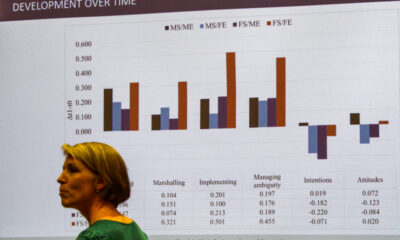
Blog
How to harness the benefits of the remote working revolution
22 December 2020
One of the most dramatic changes that 2020 has brought is the revolution in remote working. Whereas the proportion of people working exclusively from home in the UK was less than 6 per cent at the beginning of the year, this number rose to a staggering 43.1 per cent in April – and at the end of 2020 remains at around 31 per cent.
Remote work has in many ways widened the chasms of societal inequality, with the highest-paid bracket of workers almost twice as likely to be able to work from home as those in the lowest-earning category. Furthermore, the dramatic fall in the number of workers who show up to the office has had a knock-on effect on people whose jobs support and serve these workers and offices.
At Nesta’s Innovation Growth Lab (IGL), we have been keen to monitor the full impact of this unwitting global experiment (in which we have become participants ourselves). Beyond our usual focus on productivity and innovation, we’ve looked at the evidence regarding many other aspects of people’s work and lives. As well as the challenges, which include widespread feelings of loneliness and isolation among home workers, our analysis identifies important opportunities for employers and employees alike. Whether the impacts ultimately prove largely positive or negative will depend on their shared ability to offer a proactive, innovative and flexible response to this extraordinary shift in the working landscape.
Key opportunities presented by the growth of remote working
1. Widen work horizons for the benefit of all
Without the geographical constraints of colocation, many employers are tapping into a larger talent pool beyond the local labour market. In a survey of hiring managers, 64 per cent said they were now more likely to consider remote candidates for a position, while the majority found the virtual hiring process a cost-effective form of talent acquisition. Companies can also channel the cost savings derived from no longer requiring expensive office space into offering higher wages and attracting more talented employees.
For employees, no longer being tied down geographically means they have the opportunity to pursue a potentially distant job offer and still remain close to their social networks – a highly attractive concept according to one recent study, which found that ‘respondents would need to be paid an additional $24,000 to no longer be near family.’
Remote work can also solve the ‘two-body problem’, whereby dual-career couples must choose between cohabiting or pursuing geographically distant job opportunities. This may particularly benefit women in heterosexual relationships, as gendered expectations still exist around who should sacrifice their career to relocate for their partner.
2. Reduce workplace prejudice and bias
As the COVID-19 pandemic took hold, the rush to adapt to perpetual remote work paved the way for new systems to develop. With face-to-face coordination no longer feasible and constant virtual meetings and messages inconvenient, research points to ‘asynchronous tacit coordination’ as a viable form of team collaboration.
Championed by the all-remote software company GitLab, this approach replaces real-time coordination with a system that allows contributors to work independently on modularised, largely independent tasks, sharing changes and results in early stages and making use of public communication channels that are visible to the broadest set of other employees. Adopting this approach has been found to allow work ‘to be executed in a distributed context, with coordination relying not on video calls (“seeing the face”) but rather on mutual observability of work (“seeing the work”)’.
While organisations have begun to favour this form of working for its positive impacts on team productivity, its output-focused approach could also be effective in reducing workplace prejudice and bias. Such bias easily creeps into managerial evaluations: analysing written performance reviews at three US companies, researchers discovered gender differences including women being more likely to receive vague feedback such as ‘do more work in person’, without any context or explanation.
3. Transform accessibility to both jobs and events
The greater accessibility that remote work offers, coupled with the focus on asynchronous, results-driven work, has the capacity to create a level playing field for those with invisible barriers that require more cognitive processing time, sensory suppression or behavioural accommodations – including autism, dyslexia and depression.
In a world where what you do matters more than where you do it or who is doing it, a wide range of people whose needs are often overlooked should be better able to contribute in a way that allows them to feel valued. Simply taking away the physical and financial barriers involved in commuting can have a huge impact on those without easy access to an office, or who may not afford or be able to do so.
This freedom of virtual access has also allowed for more climate-friendly and inclusive online events which may have previously been inaccessible to those who were unable to travel. For example, we found that switching the IGL Global Conference to an online platform meant that a more diverse range of countries (36 in total) were represented, and useful networking opportunities were created for a wider range of people – including junior researchers who often use conferences as a way to meet future collaborators. But to make the most of this opportunity, hiring managers and event organisers need to be intentional about going beyond their existing networks and reaching out to new audiences and potential applicants.
4. Embrace more relaxed hierarchical structures
Switching to a virtual system of communication has eroded workplace hierarchical structures. The ability to peek into our colleagues’ private lives has rendered them more relatable; it can be positive to observe that our managers have families, homes to run and personal struggles too. Organisations are encouraged to embrace this shift by leaning into ‘more human’, inspirational forms of leadership – not least because traditional, hierarchical forms of leadership rely on socio-emotional cues, and therefore cease to work well outside the in-person context.
How to limit the downsides of remote working
1. Ensure that all employees can exercise agency over how they present their identities
The dissolution of certain workplace structures as a result of remote working can, however, have divisive aspects. This new insight into a colleague’s personal life may be rewarding for some, but othering for ‘anyone who doesn’t fit this ideal image of professionalism’. Allowing people to see where and how we live sends indicators regarding our social class, ethnic background and how we identify – messages that may not benefit everyone fairly. For example, it has been found to ‘increase Black workers’ vulnerability to biases and judgments of their professionalism’.
Viewing colleagues’ living spaces alongside one another during video meetings leads to both overt and subliminal social comparisons which tend to serve those in more privileged positions. Navigating this necessitates respecting boundaries, adjusting our expectations and allowing for more flexibility around how people choose to engage. Though being privy to the inner lives of our colleagues can be a bonding, levelling experience in some ways, it is not a ‘right’ and should be approached with the appropriate amount of care and respect for people’s needs and wishes.
2. Overcome ‘presenteeism’
Failure to introduce a fair and outcome-focused system to reward and acknowledge work that is done remotely could lead to an ‘out-of-sight, out-of-mind’ approach and exacerbate bias. This danger is greatest in hybrid teams composed of both office-based and remote colleagues, where managers may be tempted to offer growth opportunities for those who show up physically. A widely-cited example comes from a randomised controlled trial (RCT) in China, where workers assigned to a work-from-home contract were promoted at lower rates despite performing as well or better than their in-office colleagues.
3. Avoid the temptation for surveillance
Alternatively, digitised work may lead to remote workers being over-surveilled: as the spike in demand for virtual monitoring tools and spy software demonstrates, many organisations are desperate to maintain their ability to scrutinise the actions of their workforce. Managers tempted to spy on their staff should keep in mind the results from a seminal laboratory experiment where researchers observed a reduction in performance when monitoring was introduced, as employees perceived this ‘as a signal of distrust and a limitation of their choice autonomy’.
Organisations would do better to favour results-based evaluation and offer incentives for good performance. These rewards, research has shown, do not necessarily need to be monetary: in an RCT among volunteers for Wikipedia, awards and recognition boosted newcomer retention even where there was no promise of financial compensation.
4. Mitigate barriers due to the digital divide
While offering greater accessibility for some, the technology itself can also create divisive barriers. A recent Nesta report on data poverty highlighted ‘individuals, households [and] communities [who] cannot afford sufficient, private and secure mobile or broadband data to meet their essential needs’. Against this backdrop, remote working can widen inequalities and limit access to jobs for some. Organisations need to recognise and tackle this issue, both by providing training to employees who may have low digital literacy, and by providing equipment to those without technology access.
IGL is currently supporting a trial through the Business Basics programme which explores the impact of technological training, by testing the hypothesis that poor data management and a lack of cyber-security awareness are barriers to small business productivity. In a predominantly virtual world, the way technology is used and understood has to be woven into the fabric of organisational attitudes.
Conclusion: more proactive responses and rigorous experimentation are needed
The remote work revolution brought on by the coronavirus pandemic has proved that working from home is possible for many more people than previously imagined. It has also offered unique opportunities to radically change our ways of working beyond the physical location. Done well, remote work can increase participation, reduce bias and improve accessibility, and also encourage a switch to more inspirational forms of leadership.
Organisations and policy-makers need to recognise the opportunities and pitfalls that remote working has brought about, and become more innovative and proactive in their approaches to collaboration, performance evaluation, rewards, hiring, training and culture. At the Innovation Growth Lab, we hope this shift will also bring about more conscious and rigorous experimentation with ways of working, in the shared quest to create new workplaces and systems that are not just more productive, but more diverse and inclusive too.
This blog was originally published on 21 December 2020, on the Nesta blog page.



